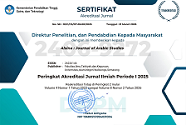Internalisasi Nilai-nilai Multikultural dalam Proses Pembelajaran Bahasa Arab di Pendidikan Tinggi
DOI:
https://doi.org/10.21580/alsina.7.1.26544Keywords:
Arabic language learning, inclusive pedagogy, Islamic higher education, multiculturalism, value internalizationAbstract
Although Arabic is the sacred language of the Qur’an and the key to understanding Islamic teachings, in Indonesia it is often misunderstood due to its association with socio-political issues. This study is significant in strengthening the values of tolerance, pluralism, and nationalism through an inclusive and humanistic Arabic language learning approach at Yudharta University Pasuruan (UYP), an Islamic boarding school–based university that upholds diversity. The aim of this research is to analyze the concept, implementation, and multicultural values internalized in Arabic language learning. The study employs a qualitative case study approach using interviews, moderate participant observation, and documentation, with data analyzed through condensation, presentation, and verification stages using source and technique triangulation. The findings show that the internalization of multicultural values at UYP is based on three main pillars: institutional policy, curriculum integration, and pesantren culture. Implementation is carried out through active and inclusive learning, value integration in assignments, and experiential field activities. The dominant values include tolerance, togetherness, equality, and cultural openness. This study produces the Multicultural Learning Ecosystem Model, illustrating that the internalization of values occurs simultaneously through structural, pedagogical, cultural, and experiential dimensions, serving as a model for multicultural-oriented Arabic language education.
Downloads
References
Abror, Mufidul, and An’im Fattach. “Urgensi Keberadaan Bahasa Arab di SMA Untuk Deradikalisasi.” Jurnal Sains Sosio Humaniora 5, no. 2 (2021): 1039–45. https://doi.org/10.22437/jssh.v5i2.16482.
Adawiyah, Yayah Robiatul et al. “Pembelajaran Bahasa Arab Berbasis Multikulturalisme Agama Melalui Metode Hypnoteaching.” Jurnal Review Pendidikan Dan Pengajaran 4, no. 1 (2021): 61–70. https://doi.org/10.31004/jrpp.v4i1.1721.
Al-Jallad, Ahmad. “An Outline of the Historical Phonology of Arabic.” Journal of Historical Linguistics 5, no. 2 (2015): 268–306. https://doi.org/10.1075/jhl.5.2.04alj.
Azra, Azyumardi. Toleransi Agama Dalam Masyarakat Majemuk: Perspektif Muslim Indonesia. Jakarta: Yayasan Abad Demokrasi, 2011.
Banks, James A. An Introduction to Multicultural Education. Boston: Pearson, 2014.
Banks, James A. The Routledge International Companion to Multicultural Education. New York: Routledge, 2009. https://doi.org/10.4324/9780203881514.
BAPPENAS RI. “Negara Republik Indonesia Tahun 1945.” Warga Dan Negara 1945 (1945): 1–166.
Departemen Pendidikan Nasional RI. UU SISDIKNAS No. 20 Tahun 2003 (2003).
Dhofier, Zamakhsyari. Tradisi Pesantren: Studi Tentang Pandangan Hidup Kyai. Jakarta: LP3ES, 2008.
Elmubarok, Zaim et al. “Pengembangan Buku Ajar Keterampilan Menulis Bahasa Arab Berbasis Kearifan Lokal sebagai Penunjang Kreativitas Mahasiswa.” Alsina : Journal of Arabic Studies 1, no. 2 (2019): 215–28. https://doi.org/10.21580/alsina.1.2.5056.
Gabsi, Zouhir. “Response to Islamophobia in the Arabic Islamic Discourse: A Critical Discourse Analysis.” Intellectual Discourse 23, no. 2 (2015): 229–54. https://doi.org/10.31436/id.v23i2.629.
Geertz, Clifford. The Religion of Java. University of Chicago Press, 1960.
Halili. “Wacana dan Gerakan Keagamaan di Kalangan Mahasiswa.” Setara Institute for Democracy and Peace, 2019, 1–9.
Hasan, Muhammad Tholchah. Pendidikan Multikultural sebagai Opsi Penanggulangan Radikalisme. Malang: Lembaga Penerbitan Universitas Islam Malang, 2016.
Isnaini, Rohmatun Lukluk. “Revitalisasi peran bahasa Arab untuk mengatasi konflik dalam perspektif multikultural.” Jurnal Pembangunan Pendidikan: Fondasi dan Aplikasi 6, no. 1 (2019): 15–26. https://doi.org/10.21831/jppfa.v6i1.22554.
Joyce, Bruce R. et al. Models of Teaching. 4th ed. Massachusetts: Allyn and Bacon, 1992.
Lickona, Thomas. Educating for Character: How Our Schools Can Teach Respect and Responsibility. New York: Bantam Books, 1992.
Margono, S. Metodologi Penelitian Pendidikan. Jakarta: Rineka Cipta, 2010.
Miles, Matthew B. et al. Qualitative Data Analysis: A Methods Sourcebook. 3rd ed. California: SAGE Publications, Inc, 2014.
Murtadlo, Muhamad. “Menakar Moderasi Beragama di Perguruan Tinggi.” Badan Litbang dan Diklat Kemenag RI, 2019.
Nisa, Luthfiyah Khoirun, and Abdul Mutholib. “Implementasi Pembelajaran Bahasa Arab Materi Qawāʿid Menggunakan Media Visual Wall Chart di Madrasah Aliyah.” Alsina : Journal of Arabic Studies 6, no. 2 (2024): 151–68. https://doi.org/10.21580/alsina.6.2.22325.
Nuruddin, Nuruddin et al. “Pembelajaran Bahasa Arab di Sekolah Indonesia Luar Negeri dengan Model Materi Ajar Berbasis Pendidikan Karakter Multikultural.” An Nabighoh 24, no. 2 (2022): 171–84. https://doi.org/10.32332/an-nabighoh.v24i2.5790.
Prayogo, Mohamad Dey, and Redi Panuju. “Makna Radikalisme dalam Lingkaran Framing Mediamorfosis, Politis, dan Ideologis.” RELASI: Jurnal Penelitian Komunikasi 1, no. 1 (2021): 17–29. https://doi.org/10.69957/relasi.v1i01.45.
Qomaruddin, Farid. “Pendidikan Bahasa Arab Berbasis Multikultural.” MIYAH: Jurnal Studi Islam 12, no. 2 (2016): 77–86.
Stainback, Susan, and William Stainback. Understanding & Conducting Qualitative Research. Reston, VA: Council for Exceptional Children, 1988.
Sugiyono. Metode Penelitian Pendidikan: Pendekatan Kuantitatif, Kualitatif, Dan R&D. Bandung: Alfabeta, 2013.
Syuhadak, and Danial Hilmi. “Pembelajaran Bahasa Arab Ditinjau dalam Perspektif Studi Multikultural di Perguruan Tinggi Keagamaan Islam Negeri Jawa Timur.” Malang, 2020.
Tim Penyusun. Statuta Universitas Yudharta Pasuruan. Pasuruan: Universitas Yudharta Pasuruan, 2019.
Williams, Donald E. Prudence Crandall’s Legacy: The Fight for Equality in the 1830s, Dred Scott, and Brown v. Board of Education. Middletown: Wesleyan University Press, 2014.
Yin, Robert K. Case Study Research: Design and Methods Third Edition. London: Sage Publications, 2003.
Yusuf, Achmad. “Best Practices Nilai-nilai Karakter Multikultural di Pesantren Ngalah Pasuruan.” AL MURABBI: Jurnal Pendidikan Agama Islam 5, no. 1 (2019): 36–56. https://doi.org/10.35891/amb.v5i1.2059.
Downloads
Published
How to Cite
Issue
Section
License

This work is licensed under a Creative Commons Attribution-NonCommercial-ShareAlike 4.0 International License.
Copyright
The copyright of the received article shall be assigned to the publisher of the journal. The intended copyright includes the right to publish the article in various forms (including reprints). The journal maintains the publishing rights to published articles. Authors are allowed to use their articles for any legal purposes deemed necessary without written permission from the journal, but with an acknowledgment to this journal of initial publication.
Licensing
In order for Alsina: Journal of Arabic Studies to publish and distribute research articles, the editors need publishing rights (transferred from author to publisher). This agreement relates to the transfer/publishing copyright license to Alsina: Journal of Arabic Studies but the authors still have significant rights to use and share their published articles.
Alsina: Journal of Arabic Studies supports the need for writers to share, disseminate and maximize the impact of their research and their rights on any database. As a journal article writer, you have the right to various uses of your articles, including that by the institution or company where you work. Copyright can be used without the need for special permission. Authors who publish articles in the Alsina: Journal of Arabic Studies have broad rights to use their work for teaching and scientific purposes without requesting permission, including:
- Use by the author for lectures, presentations, or conferences, with distribution of copies to participants;
- Distribution to colleagues for research use;
- Use in compilations of the author's subsequent work;
- inclusion in a thesis or dissertation;
- Reuse of sections or excerpts from articles in other works (with full acknowledgment of the final article);
- Preparation of derivative works (other than commercial purposes) (with full acknowledgment of the final article);
- Voluntary posting on open websites operated by authors’ or writers' agencies for scientific purposes
When submitting a manuscript, authors do so on the understanding that if accepted for publication, the copyright for publishing (publishing right) of the article shall be assigned/transferred to Alsina: Journal of Arabic Studies.
Authors whose articles are accepted for publication will receive confirmation via email and sent a Copyright Transfer Agreement.

 Accreditation
Accreditation 
 In Collaboration with
In Collaboration with 

 Visitors
Visitors  Article Template
Article Template





